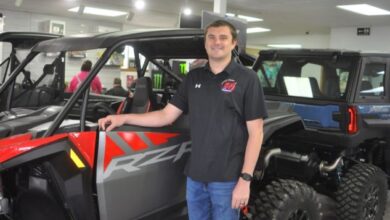A case of good news, bad news for dealers – July 3, 2006
Powersports dealerships are doing an increasingly better job in the eyes of consumers, but it’s meaning less and less, according to an annual survey.
The sobering findings were part of this year’s J.D. Power and Associates Motorcycle Competitive Information Study, a survey of more than 8,000 new bike buyers.
Dealers in the latest study were given the two highest ratings (either a 9 or 10 on a 1 to 10 scale) by more than 58 percent of consumers — a 6 percent increase over five years ago. (The 2000 survey was conducted on a 6-point scale.) Plus, an additional 25 percent of consumers gave dealers an 8 or 7 mark in this year’s survey.
The problem? Consumers indicated that “best deal/lowest price” was an increasing reason for selecting the dealership they went to while “past experience with dealer” slipped noticeably compared to five years ago.
“Really, the only way to combat it is to offer alternatives to price alone, to be sure to offer other reasons to buy from you,” said Kurt Finley, president of Colorado Powersports, Boulder, Colo. “It could be your facility, location, relationships; too often the dealer personnel surrender to price. Price is always a factor, but it’s not No. 1 in most surveys.”
In fact, the No. 1 reason for buying from a dealership, according to customers in the J.D. Power and Associates 2005 survey, was the dealer had the desired motorcycle (color option, etc.). Still that No. 1 reason — cited by 23.8 percent of those surveyed — was followed closely by “best deal/lowest price” at 21 percent. That’s much different than in 2000 when “best deal” was the fourth reason picked by consumers at 15 percent.
“I can’t tell if the survey response refers to the lowest price or simply to a fair price,” Finley said. “When demand is high and supply low, some dealers can get overly aggressive. A lot of people like to do business with their local dealer, but feel they just can’t if he or she isn’t perceived to be fair on pricing.”
Ralph DeLuco, president of Canton Cycles, Inc., Winsted, Conn., said the service department is “the best way to counteract” the price issue.
“You have to take care of them after the sale,” said DeLuco, who is also president of the Connecticut Motorcycle Business Association. “We have good techs and take good care. Also, we give them 10 percent off OEM parts and labor for two years if they buy a new bike, and for one year on a used bike.”
Pamela Herndon, general manager of Michael’s Reno Powersports, Reno, Nev., agrees that service is key.
“The discounters are always down the street,” she said, “but you always have to do business as you have to; big dealers can’t discount as they have too much overhead. You have to offer service.”
But staying connected with the consumer after the new bike purchase seems to be a troubling issue. The survey shows fewer consumers are taking “past experience with a dealer” into account now (about 15 percent) than in 2000 (nearly 20 percent.)
“The best thing we have to offer the customer is a relationship that survives the point of purchase,” said Finley. “The dealer can add value to the purchase by offering events, activities, ways to get in touch with others who ride. Become a facilitator of the sport.”
Jim Avellino, sales manager at Bettencourt’s Honda/Suzuki, West Bridgewater, Mass., also advocates dealers sell their expertise.
“We’re here to sell the whole dealership, and what I sell is knowledge,” said Avellino. “I want to give them such good knowledge that if they go somewhere else and don’t get it, they will want to come back here.
“I won’t close every deal, but I’ve had people tell me that they could have bought the bike for a couple hundred dollars cheaper elsewhere, but they wanted to buy from me because of my knowledge.”
The 2005 J.D. Power and Associates survey did offer this bit of comforting news to dealers — their location is still a big key to sales. More than 17 percent of consumers picked “conveniently located” as the No. 1 reason for using a dealership.
“Most dealers, if given the chance, will not let their local customers travel to a discount dealer,” said Phil Smith, sales manager of Cal Coast Motorsports in Ventura, Calif. “With proper sales training, customers can usually be sold on the benefits of buying from his local dealership.”
Plus, the discounter that could lure consumers away from the local dealership may not have everything a consumer would desire, Smith said.
“Usually, the low-price guy has nothing else to offer and his facility is substandard, not only in appearance but also in the quality of his employees,” Smith said. “How can a dealer who operates on minimal profit afford to pay good technicians, stay open late, give good discounts on accessories, give free delivery and a host of other services when there is little or no profit involved?
“The dealership that strives to make a little more margin on his product usually has a facility that is more becoming of a new franchise and with those slightly higher margins he can offer the best financing rates, more generous trade-in allowances, perhaps a free helmet or other items that would make the customer feel like he got a ‘good deal.’” psb




